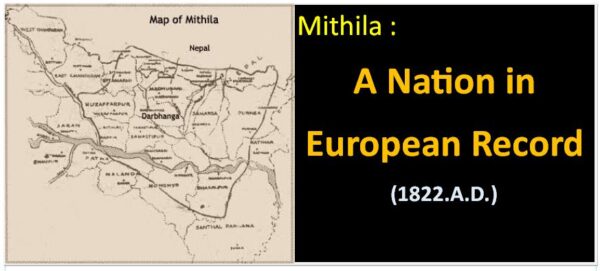मिथिला आ मैथिलीक लेल आइ भलें संघर्ष करबाक स्थिति आबि गेल हो; आ हिन्दी एकरा उदरस्थ करबाक लेल हाथ-पएर मारि रहल हो; अंगिका, बज्जिका, भोजपुरी ई सभ भिनाउज करबाक लेल उताहुल हो’ मुदा इतिहास इएह कहैत अछि जे 1822 ई.मे विदेशी विद्वान सभ मिथिला कें एकटा राष्ट्र आ मैथिली भाषा कें भारतक दस भाषामे सँ एक भाषा मानने छथि।
लन्दनमे 1775 ई.मे जनमल फ्रेडरिक शोबर्ल अथवा फ्रेडरिक स्कोबर्ल पत्रकार, सम्पादक,अनुवादक आदिक संग एकटा चित्रकार सेहो रहथि। Rudolph Ackermann’s Repository of Arts क लेल ई हिन्दुस्तान पर एकटा पुस्तकक संपादन कएने छथि। एहि पुस्तकमे संकलित तथ्य सभ डच इस्ट इंडिया कम्पनीक द्वारा संकलित कएल गेल अछि। एकर पहिल प्रकाशन 1822 ई.मे भेल आ 1827 ई.मे दोसर संस्करण सेहो प्रकाशित भेल। एतए दोसर संस्करणक उपयोग कएल गेल अछि।
विवरणक मैथिली अनुवाद
“भारतमे 10 टा प्रमुख भाषा छल जे एही नामक दस टा सुसंस्कृत राष्ट्रक लोकसभक द्वारा बाजल जाइत अछि से हिन्दुस्तान आ दक्कनक सभ क्षेत्रकें समेटने छल। ओ भाषा सभ अछि-
- प्राकृत, जकरा विषयमे पूर्वमे कहि चुकल छी।
- कान्यकुब्ज, जे आधुनिक हिन्दुस्तानीक आधार थीक आ ओ एखनहुँ भारतक आन्तरिक भागक गाम सभमे बाजल जाइत अछि।
- गौड़ अथवा बंगाली जाहिमे संस्कृत सँ अनूदित अनेक रचनाक अतिरिक्त किछु मौलिक पद्यरचना भेटैत अछि।
- मैथिल (वर्तमान मैथिली) अथवा तिरहुत्या (तिरहुतिया) जे सरकार-ए-तिरहुत आ ओकर सीमावर्ती जिलामे बाजल जाइत अछि।
- उरिगा (वर्तमान ओड़िया), जे उड़ीसाक तटवर्ती क्षेत्रमे बाजल जाइत अछि।
- गुजरातमे गुजराती
- तमुल (वर्तमान तमिळ), जेकरा यूरोपीय सभक द्वारा मालाबार कहल जाइत अछि, जे केप कोमेरिन सँ सुदूर भारत धरि 12सँ 13 अंश उत्तरी अक्षांशक बीच बाजल जाइत अछि।
- महरट्टा (वर्तमान मराठी) जाहिमे तर्कशास्त्र आ दर्शनक किछु शास्त्रीय ग्रन्थ अछि, संगहि एहिमे मुख्य रूपसँ राम आ कृष्णक गौरवगाथासँ सम्बन्धित किछु मौलिक काव्य अछि आ संस्कृतसँ किछु अनुवाद अछि।
- कनरा (वर्तमान कन्नड़), कर्नाटकक प्राचीन भाषा
- तेलिंग (वर्तमान तेलुगू), जाहिमे पूर्ववर्ती कविलोकनि रचना कएने छथि आ एखनहु एही नामक राज्यमे बाजल जाइत अछि।
मुसलमान राजकुमारक दरबारसभमे मुगलक भाषा बाजल जाइत अछि जे अरबी, तार्तर आ फारसीक सम्मिश्रण थीक। ई सभसँ अंतमे उल्लिखित भाषा अछि जे यूरोपियन आ हिन्दू राजकुमारसभक बीच प्रशासनिक काजसभक लेल सम्पर्क-भाषाक रूपमे प्रयोग कएल जाइत अछि।”
पुस्तकक विवरण
(सम्पादक- फ्रेडरिक शोबर्ल, द वर्ल्ड इन मीनिएचर, हिन्दुस्तान, जाहिमे हिन्दूक विवरण, धर्म, लोक-व्यवहार, रीति-रिवाज, व्यापार, कला, विज्ञान, साहित्य आ विभाजन आदि वर्णित अछि, जे एक सय सूक्ष्मचित्रक द्वारा देखाओल गेल अछि, छह खण्डमे, पाँचम खण्ड, लन्दनसँ प्रकाशित, आर. अकरमैनक कला-संकलन अन्य सभ पुस्तक-विक्रेताक लेल मुद्रित, 1827 ई., पृ.संख्या-133-135)
Original Quote
“There were ten principal dialects spoken by the same number of civilised nations who occupied the provinces of Hindoostan and Deccan. Several of these dialects are still in current use. These are-
- the Pracrit of which we have already treated.
- the Canyacubya which seems to be the groundwork of the modern Hindoostanee and which is still spoken in the villages in the interior of the country.
- the Gaura or Bengalee which has some original poems besides many translations from the Sanscrit.
- the Maithila or Tirhuctya used in the sircar of Tirhut and the adjoining districts.
- the Uriga spoken on the coast of Orissa
- the Gurjera in Guzerat.
- the Tamul called by the Europeans Malabar, spoken from Cape Comorin the southern extremity of India to the 12th or 13th degree of north latitude.
- the Mahratta in which there are some treatises of logic and philosophy besides many original poems chiefly in honour of Rama and Crishna and some translations from the Sanscrit.
- the Canara the ancient language of the Carnatic.
- the Telinga formerly cultivated by the poets and still spoken in the province of that name.
At the courts of the Mahometan princes the Mogul language a mixture of the Arabic Tartar and Persian is spoken. It is in the last-mentioned language that all diplomatic business between the Europeans and the Hindoo princes is transacted.”
(Frederic Shoberl, (Frederick Schoberl) The World In Miniature, Hindustan, containing a description of the religion manners customs trades arts sciences literature diversions &c. of The Hondoos, illustrated with upwards of one hundred coloured engravings in six volumes, vol v, London, printed for R. Ackermann repository of arts, strand; and to be had of all booksellers, 1827 A.D., pp-133-135)

Comments are closed, but trackbacks and pingbacks are open.